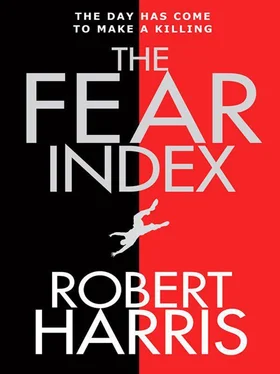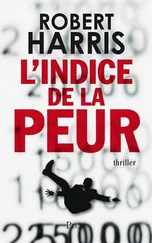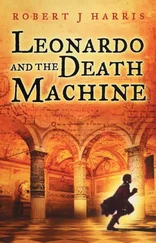Robert Harris - The Fear Index
Здесь есть возможность читать онлайн «Robert Harris - The Fear Index» весь текст электронной книги совершенно бесплатно (целиком полную версию без сокращений). В некоторых случаях можно слушать аудио, скачать через торрент в формате fb2 и присутствует краткое содержание. Жанр: Триллер, на английском языке. Описание произведения, (предисловие) а так же отзывы посетителей доступны на портале библиотеки ЛибКат.
- Название:The Fear Index
- Автор:
- Жанр:
- Год:неизвестен
- ISBN:нет данных
- Рейтинг книги:4 / 5. Голосов: 1
-
Избранное:Добавить в избранное
- Отзывы:
-
Ваша оценка:
- 80
- 1
- 2
- 3
- 4
- 5
The Fear Index: краткое содержание, описание и аннотация
Предлагаем к чтению аннотацию, описание, краткое содержание или предисловие (зависит от того, что написал сам автор книги «The Fear Index»). Если вы не нашли необходимую информацию о книге — напишите в комментариях, мы постараемся отыскать её.
The Fear Index — читать онлайн бесплатно полную книгу (весь текст) целиком
Ниже представлен текст книги, разбитый по страницам. Система сохранения места последней прочитанной страницы, позволяет с удобством читать онлайн бесплатно книгу «The Fear Index», без необходимости каждый раз заново искать на чём Вы остановились. Поставьте закладку, и сможете в любой момент перейти на страницу, на которой закончили чтение.
Интервал:
Закладка:
Elmira Gulzhan said, ‘That is al-Qaeda.’
‘Partly. But why should al-Qaeda arouse more fear than the threat of mutually assured destruction did during the Cold War in the fifties and sixties – which, incidentally, were times of great market growth and stability? Our conclusion is that digitalisation itself is creating an epidemic of fear, and that Epictetus had it right: we live in a world not of real things but of opinion and fantasy. The rise in market volatility, in our opinion, is a function of digitalisation, which is exaggerating human mood swings by the unprecedented dissemination of information via the internet.’
‘And we’ve found a way to make money out of it,’ said Quarry happily. He nodded at Hoffmann to continue.
‘As most of you will be aware, the Chicago Board of Exchange operates what is known as the S and P 500 Volatility Index, or VIX. This has been running, in one form or another, for seventeen years. It’s a ticker, for want of a better word, tracking the price of options – calls and puts – on stocks traded in the S and P 500. If you want the math, it’s calculated as the square root of the par variance swap rate for a thirty-day term, quoted as an annualised variance. If you don’t want the math, let’s just say that what it does is show the implied volatility of the market for the coming month. It goes up and down minute by minute. The higher the index, the greater the uncertainty in the market, so traders call it “the fear index”. And it’s liquid itself, of course – there are VIX options and futures available to trade, and we trade them.
‘So the VIX was our starting point. It’s given us a whole bunch of useful data going back to 1993, which we can pair with the new behavioural indices we’ve compiled, as well as bringing in our existing methodology. In the early days it also gave us the name for our prototype algorithm, VIXAL-1, which has stuck all the way through, even though we’ve moved way beyond the VIX itself.
We’re now on to the fourth iteration, which with notable lack of imagination we call VIXAL-4.’
Klein jumped in again. ‘The volatility implied by the VIX can be to the up side as well as the down side.’
‘We take account of that,’ said Hoffmann. ‘In our metrics, optimism can be measured as anything from an absence of fear to a reaction against fear. Bear in mind that fear doesn’t just mean a broad market panic and a flight to safety. There is also what we call a “clinging” effect, when a stock is held in defiance of reason, and an “adrenalin” effect, when a stock rises strongly in value. We’re still researching all these various categories to determine market impact and refine our model.’ Easterbrook raised his hand. ‘Yes, Bill?’
‘Is this algorithm already operational?’
‘Why don’t I let Hugo answer that, as it’s practical rather than theoretical?’
Quarry said, ‘Incubation started back-testing VIXAL-1 almost two years ago, although naturally that was just a simulation, without any actual exposure to the market. We went live with VIXAL-2 in May 2009, with play money of one hundred million dollars. When we overcame the early teething problems we moved on to VIXAL-3 in November and gave it access to one billion. That was so successful we decided to allow VIXAL-4 to take control of the entire fund one week ago.’
‘With what results?’
‘We’ll show you all the detailed figures at the end. Off the top of my head, VIXAL-2 made twelve million dollars in its six-month trading period. VIXAL-3 made one hundred and eighteen million. As of last night, VIXAL-4 was up about seventy-nine-point-seven million.’
Easterbrook frowned. ‘I thought you said it had only been running a week?’
‘I did.’
‘But that means…’
‘That means,’ said Ezra Klein, doing the calculation in his head and almost jumping out of his chair, ‘that on a ten-billion-dollar fund, you’re looking at making a profit of four-point-one-four billion a year.’
‘And VIXAL-4 is an autonomous machine-learning algorithm,’ said Hoffmann. ‘As it collects and analyses more data, it’s only likely to become more effective.’
Whistles and murmurs ran around the table. The two Chinese started whispering to one another.
‘You can see why we’ve decided we want to bring in more investment,’ said Quarry with a smirk. ‘We need to exploit the hell out of this thing before anyone develops a clone strategy. And now, ladies and gentlemen, it seems to me that this might be a suitable moment to offer you a glimpse of VIXAL in operation.’
Three kilometres away, in Cologny, forensics had completed their examination of the Hoffmanns’ house. The scene-of-crimes officers – a young man and woman, who might have been students or lovers – had packed up their equipment and left. A bored gendarme sat in his car on the drive.
Gabrielle was in her studio, dismantling the portrait of the foetus, lifting each sheet of glass out of its slot on the wooden base, wrapping it in tissue paper and then in bubble wrap, and laying it in a cardboard box. She found herself thinking how strange it was that so much creative energy should have flowed from the black hole of this tragedy. She had lost the baby two years ago, at five and a half months: not the first of her pregnancies that had ended in a miscarriage, but easily the longest and by far the most shattering. The hospital had given her an MRI scan when they began to get concerned, which was unusual. Afterwards, rather than stay on her own in Switzerland, she had gone with Alex on a business trip to Oxford. Wandering round a museum while he was interviewing PhDs in the Randolph Hotel, she had come across a 3D model of the structure of penicillin built up on sheets of Perspex in 1944 by Dorothy Hodgkin, the Nobel laureate for chemistry. An idea had stirred in her mind, and when she got home to Geneva, she had tried the same technique on the MRI scan of her womb, which was all she had left of the baby.
It had taken a week of trial and error to work out which of the two hundred cross-sectional images to print off, and how to trace them on to glass, what ink to use and how to stop it smearing. She had sliced her hands repeatedly on the sharp edges of the glass sheets. But the afternoon when she first lined them up and the outline had emerged – the clenched fingers, the curled toes – was a miracle she would never forget. Beyond the window of the apartment where they had lived in those days, the sky had turned black as she worked; brilliant yellow flashes of forked lightning had stabbed down over the mountains. She knew nobody would believe it if she told them. It was too theatrical. It had made her feel as if she were tapping into some elemental force: tampering with the dead. When Alex came home from work and saw the portrait, he had sat stunned for ten minutes.
After that she had become utterly absorbed by the possibilities of marrying science and art to produce images of living forms. Mostly she had acted as her own model, talking the radiographers at the hospital into scanning her from head to toe. The brain was the hardest part of the anatomy to get right. She had to learn which were the best lines to trace – the aqueduct of Sylvius, the cistern of the great cerebral vein, the tentorium cerebellum and the medulla. The simplicity of the form was what appealed to her most, and the paradoxes it carried – clarity and mystery, the impersonal and the intimate, the generic and yet the absolutely unique. Watching Alex going through the CAT scanner that morning had made her want to produce a portrait of him. She wondered if the doctors would let her have his results, or if he would allow her to do it.
She wrapped up the last of the glass sheets tenderly, and then the base, and sealed the cardboard box with thick brown sticky tape. It had been a painful decision to offer this, of all her works, to the exhibition: if someone bought it, she knew she would probably never see it again. And yet it seemed to her an important thing to do: that this was the whole point of creating it in the first place – to give it a separate existence, to let it go out into the world.
Читать дальшеИнтервал:
Закладка:
Похожие книги на «The Fear Index»
Представляем Вашему вниманию похожие книги на «The Fear Index» списком для выбора. Мы отобрали схожую по названию и смыслу литературу в надежде предоставить читателям больше вариантов отыскать новые, интересные, ещё непрочитанные произведения.
Обсуждение, отзывы о книге «The Fear Index» и просто собственные мнения читателей. Оставьте ваши комментарии, напишите, что Вы думаете о произведении, его смысле или главных героях. Укажите что конкретно понравилось, а что нет, и почему Вы так считаете.










